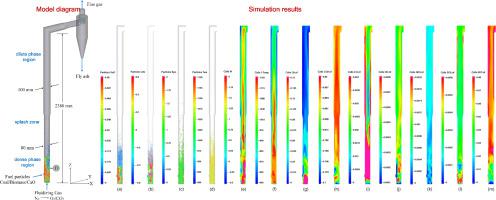Powder Technology ( IF 4.5 ) Pub Date : 2021-09-22 , DOI: 10.1016/j.powtec.2021.09.049 Qinwen Liu 1, 2 , Wenqi Zhong 1, 2 , Aibing Yu 2, 3 , Chi-Hwa Wang 4

|
The oxy-fuel co-firing of solid fuels (such as coal, biomass, and solid waste) in fluidized beds is one of the most promising technologies for the industrial application of CO2 capture and waste disposal. However, both the practical experimentation and numerical simulations for elucidating co-firing in an oxy-fuel fluidized bed are still limited. In this study, a multiphase particle-in-cell scheme based on a 3D Eulerian–Lagrangian model was further developed following our previous research on oxy-fuel co-firing in a micro fluidized bed (Powder Technol. 2020, 373, 522–534). The refined JL 4-step mechanism for the CO-CO2 homogeneous reactions, the heterogeneous reactions of char oxidation and gasification, the heterogeneous reactions of NO and N2O formation from char-N, and the self-desulfurization effect were comprehensively considered. The improvement of the models was verified through the continuous operation of 10 kWth oxy-fuel fluidized bed tests (Fuel 2021,286,119,312; Energy Fuels, 2020, 34, 7373–7387), and the effects of the biomass blending ratio (Mb) on co-firing characteristics were discussed. It was found that the improvements could enhance the adaptability of the models to the oxy-fuel atmosphere, and the accurate prediction of NO, N2O, SO2. With an increase in Mb, the main reaction zone expanded or moved up along the riser height, and the volume of the high-temperature area increased, which promoted the burnout of particles and CO2 emission when Mb is 50%. The high volatility of biomass increased O2 consumption and CO concentration at the upper part of the riser, reduced N2O formation, and had a significant impact on NO reduction. The low sulfur content and high Ca/S ratio of the biomass considerably reduced the SO2 concentration. The simulation results also provided helpful information for the design and operation control of oxy-fuel co-firing of coal and biomass in a fluidized bed, such as the oxidant supply in different areas and grades, appropriate increase in the riser height, and reasonable adoption of Mb.
中文翻译:

模拟煤和生物质在 10 kWth 氧燃料流化床中的混合燃烧
固体燃料(如煤、生物质和固体废物)在流化床中的氧燃料混烧是CO 2捕集和废物处理工业应用最有前途的技术之一。然而,用于阐明氧燃料流化床共烧的实际实验和数值模拟仍然有限。在这项研究中,继我们之前对微流化床中氧燃料共烧的研究 (Powder Technol. 2020, 373, 522–534 )。CO-CO 2均相反应、焦炭氧化和气化的多相反应、NO 和 N 2的多相反应的精制 JL 4 步机理综合考虑炭-N生成O和自脱硫效果。通过连续运行 10 kW th氧燃料流化床试验(Fuel 2021,286,119,312;Energy Fuels, 2020, 34, 7373–7387),以及生物质混合比的影响(M b ) 对混烧特性进行了讨论。发现改进后的模型对氧-燃料气氛的适应性增强,NO、N 2 O、SO 2的准确预测。随着M b的增加,当M b为50%时, 主反应区沿提升管高度扩大或向上移动, 高温区体积增大, 促进了颗粒物的燃尽和CO 2 的排放。生物质的高挥发性增加了立管上部的O 2消耗和CO 浓度,减少了N 2 O 的形成,对NO 的还原有显着影响。生物质的低硫含量和高 Ca/S 比大大降低了 SO 2专注。模拟结果也为煤与生物质富氧混烧流化床的设计和运行控制提供了有益的信息,如不同区域和等级的氧化剂供应,适当增加立管高度,合理采用的M b。











































 京公网安备 11010802027423号
京公网安备 11010802027423号